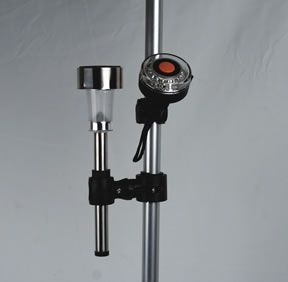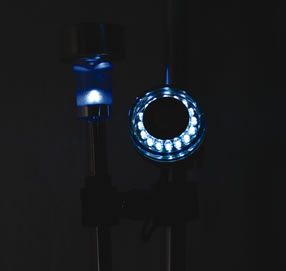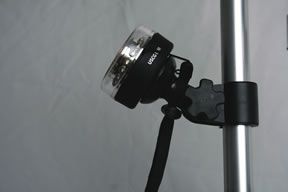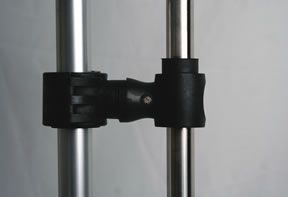
288

288
Over the years, we’ve seen many creative solutions for on-deck lighting. Armed with uncanny resourcefulness—and a roll of duct tape—many skippers will lash anything that glows to a pulpit, a stay, or their own hat to ensure that they can see and be seen. It was with this in mind that we launched a test of two LED rail lights.
Practical Sailor tested the solar-powered RailLight Mini, made by the Oregon-based, green-product maker Simply Brilliant, and the battery-powered Navilight 360, which is made by Navisafe, a Norwegian manufacturer of lights for outdoor enthusiasts. Both lights use multiple LEDs for illumination, but neither is certified as a U.S. Coast Guard-approved navigation light. However, the Navilight 360 is a USCG-certified MOB marker (certified visible up to 1 nautical mile), and its maker said the light is in the process of becoming USCG-certified as a nav light. (The USCG requires stern lights to be certified as visible up to 2 nautical miles.)
How We Tested
For comparison, testers examined both lights’ construction quality and tested the brightness of the lights with a Meter-man light meter. These readings were measured in lux, which is the density of light that falls on a surface and is equal to one lumen per square meter.
To gauge battery life, testers placed three fresh AAA batteries in the Navilight 360 and let the RailLight soak up some sunshine for nine hours, which was an hour more than required for a full charge, then monitored the lights until they quit shining. Testers also sprayed both lights and then dunked them in water for 30 minutes to determine whether they would stand up to service on a boat; neither light showed any sign of water intrusion. We dropped the lights from 6 feet onto cement to gauge ruggedness. In final ratings, testers also considered price, warranty, features, and versatility.
NaviLight 360
Shaped like a hockey-puck, the Navilight 360 employs 16 bright LEDs for a 360-degree light output. The LEDs are housed in a sealed nylon body with a double-magnetic back. There are four super-strong magnets in the body, and four in the light’s removable backing plate. It’s this system of magnets that enables users to “mount” the light just about anywhere. While the maker does sell various styles of mounts for the Navilight 360—bendable suction-cup rail mount, telescoping aluminum pole mount, etc.—users can also affix it to clothing, life jackets, bimini tops, etc. by placing the material between the backing plate and the light housing magnets. When choosing a mounting location for the Navilight 360, be sure it’s far enough away from the boat’s compass so that it doesn’t interfere with the compass reading; in our tests, the super-strong magnets that make the light so versatile also caused our compass to go a little haywire when it was within a few feet.
Testers liked the Navilight 360’s tether—something we’d like to see on all small, portable boat gear. The tether ensured that even if the light was knocked off its magnetic mount, it wouldn’t be lost overboard. Both test lights became detached from their mounts during our drop test, so we were glad to see Navisafe include the tether.
We tested the Navilight 360 with its articulating clamp-on rail mount. Attaching the mount was fast and simple: Testers lefty-loosied the adjustment knob, slid the mount around the 1-inch stern pulpit rail and tightened the knob; we removed the light’s backing plate, cinched its tether to the mount, and stuck the light on the mount’s flat, magnetic head. No tools were needed.
The Navilight 360, which runs on three AAAs, was noticeably brighter than the RailLight, and it maintained its brightness after 24 hours of constant full-power use. It has many more LED bulbs than the RailLight, and their 360-degree placement helps make the light brighter. Where the RailLight put out a glow of light, the Navilight 360 put out a halo. For those times when users do not want the full 360 degrees of light—to protect night-vision for instance—there are multiple lighting modes. It can shine all 16 LEDs (360 degrees), six LEDs (135 degrees), or four (dim setting); the light also has an emergency flashing function.
The Navilight 360 is submersible to 60 feet, and it floats with the light shining up. This thoughtful design feature makes it more than an amenity, in our opinion. It makes it a useful safety item as it can be used to mark a man-overboard’s position or can be worn on a life jacket or foul-weather gear and used as an MOB light.
Bottom line: The Navilight 360 is a bright, easy-to-use, and versatile light that has added value as an MOB marker. Its $60 price tag is comparable to most high-end LED headlamps and waterproof personal lights. We recommend it.

288

288
RailLight
Simply Brilliant’s RailLight Mini is the petite little sister of the RailLight Premium, which we featured in the Dec. 1, 2005 Chandlery. The RailLight’s marine-grade stainless and UV-resistant polycarbonate sealed housing protects its two white LEDs, which are powered by an NiMH battery that is charged via a 1.5-square-inch solar panel. While it looks similar to those solar yard lights, it was designed and built for marine use. The battery-free RailLight’s design means less hassle for the environment and for the user: There are no wires to contend with and no batteries to continually replace.
Despite the small size of the solar panel, the RailLight turns one hour of sunlight into one hour of LED light, and is fully charged with eight hours of sun. In our test, the RailLight continued to shine beyond 24 hours on a nine-hour charge. However, the light output was very dim and mostly unusable after about 15 hours of being continuously on.
Testers’ favorite feature of the RailLight is its internal light sensor, which enables it to power on automatically. It can charge all day in the sun, and when dusk arrives, it turns itself on. A sealed power switch under the lamp hood allows for manual powering on. This mount-it-and-forget-it feature would be especially useful for boats that are moored and left unattended for long periods, or for sailors returning to their boat after dark.
Testers’ only nit-pick with the RailLight was its lamp hood, which popped off during our drop test. Had it been dropped onboard a boat or snagged by an errant dockline, it likely would have been a goner; we’d be sure to glue the lamp hood to the post before mounting the light. Mounting the bracket required a Phillips-screwdriver and one small (supplied) screw that could easily be dropped overboard. The bracket, which can be mounted vertically or horizontally, comes with three rubber gaskets to accommodate different diameters of railings up to 1.25 inches.
The nice thing about the mounting bracket is its quick-release feature. Once all the futzing has been done with mounting, the torch can be quickly and easily slid out of the bracket.
The RailLight sells for $30 and comes with a two-year warranty.
Bottom line: The RailLight is the PS Budget Buy. We recommend it for boat owners looking for a reliable, automatic light that doesn’t require batteries.
Conclusion
Although carrying lights on deck that can be mistaken for nav lights is illegal according to the International Navigation Rules, we still see many feasible uses for these lights (cockpit lighting at anchor, to help you find your boat in a dark mooring field, etc.). And although the RailLight lacks the strength and light arc to ever be mistaken as a nav light, we suggest mounting either light where they won’t be mistaken as nav lights if used underway.
The Navilight was clearly the stronger light and more versatile product, but we see these two rail lights as serving different niches, and both have their pros and cons. We recommend the battery-powered Navilight for those seeking a versatile light that has limitless mounting options. Priced at $30 less, the battery-free RailLight is a reliable, weather-resistant, automatic light.


































